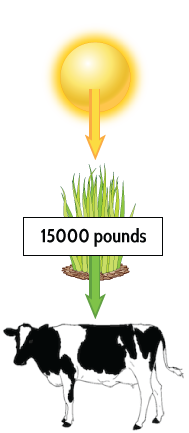What is the ultimate source of energy for terrestrial ecosystems?
Energy from the sun is captured by organisms at which trophic level?








primary producers
secondary consumers
primary consumers
tertiary consumers



tertiary consumers
secondary consumers
primary consumers

primary producers



What percentage of biomass from each trophic level is converted into biomass in the next trophic level above it?
Imagine that a village of 100 starving people has a limited area for growing grain. The people of the village have two options for any grain that is produced: a) they can harvest the grain and use it to feed themselves, or b) they can harvest the grain, use it to feed a cow, and then eat the cow. Different members of the village have dissenting opinions on the best strategy. Let’s examine the merits of each option from an energy efficiency point of view.
NEXT
Let’s assume that the crops in the field are able to capture enough energy from the sun to produce 15,000 pounds of grain.
If all of the grain were used to feed the villagers, how much of the original 15,000 pounds would be converted to biomass by the villagers?

Let’s continue to assume that the crops in the field are able to capture enough energy from the sun to produce 15,000 pounds of grain.
If all of the grain were used to feed a single cow, how much of the original 15,000 pounds would be converted to biomass by the cow (i.e. how much would the cow grow to weigh if it were fed 15,000 pounds of grain)?

If the cow were now eaten by the community, how much of the original 1,500 pounds would be converted to biomass by the villagers?

Many ecosystems have a pyramid of biomass that is shaped similarly to
the one shown: the primary producer level is the largest, and each
succeeding consumer level is smaller than the one below it. (Inefficiencies
in the transfer of energy from one trophic level to the next explain why
there are so many more plants than animals.) However,
some ecosystems have pyramids of biomass with slightly different shapes.
We will explore these variations in the next question.

NEXT
This type of pyramid supports a relatively large biomass of
consumers and is common in rain forests, marshes, and algal
beds.
In this type of pyramid, a small biomass of producers supports a
relatively large biomass of consumers. It occurs in some aquatic
ecosystems where plankton are primary producers.
This type of pyramid has a reduced ability to support consumers
and is common in deserts, tundras, and open oceans.



